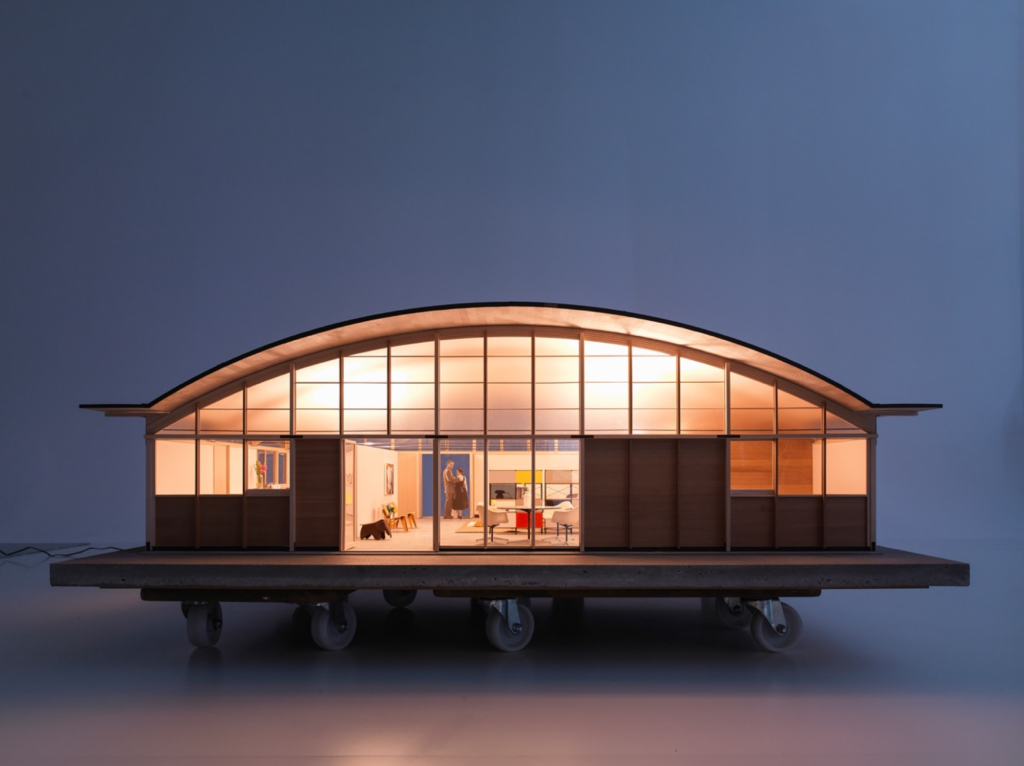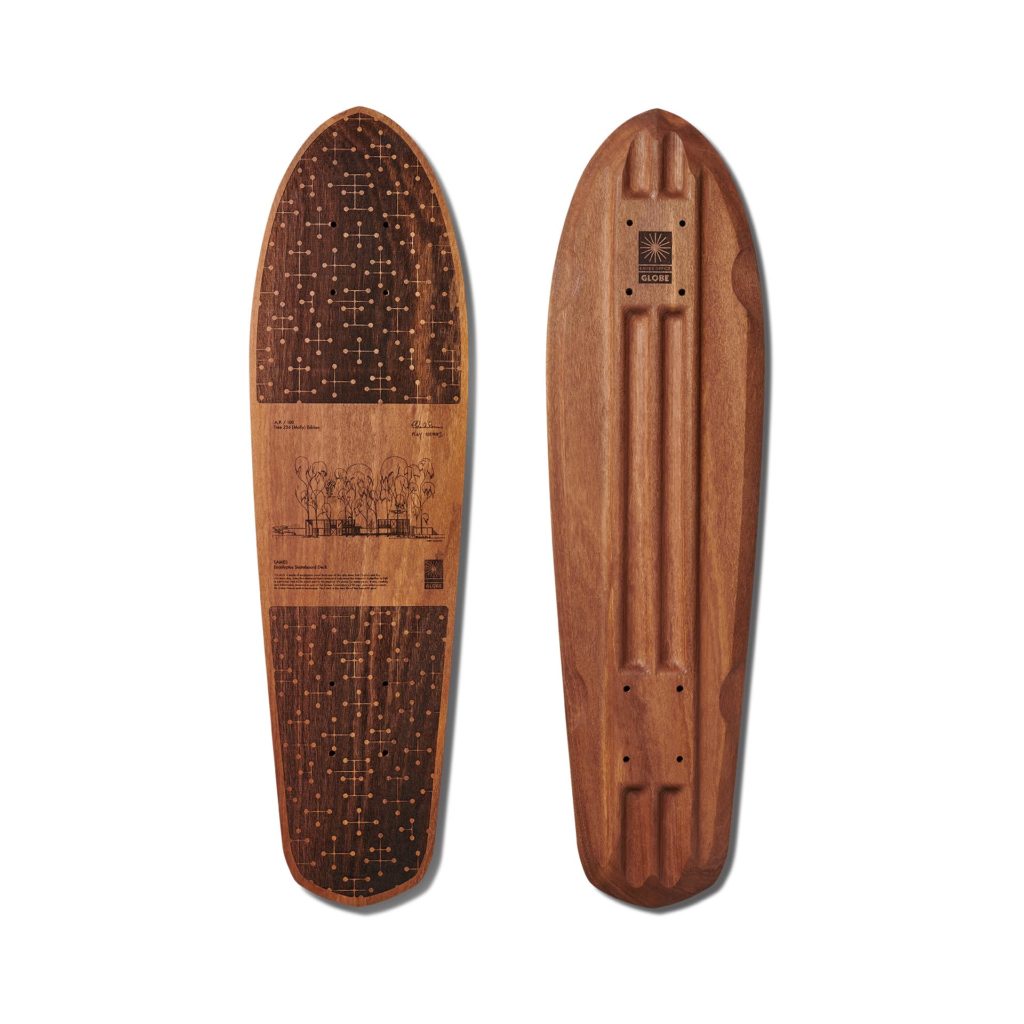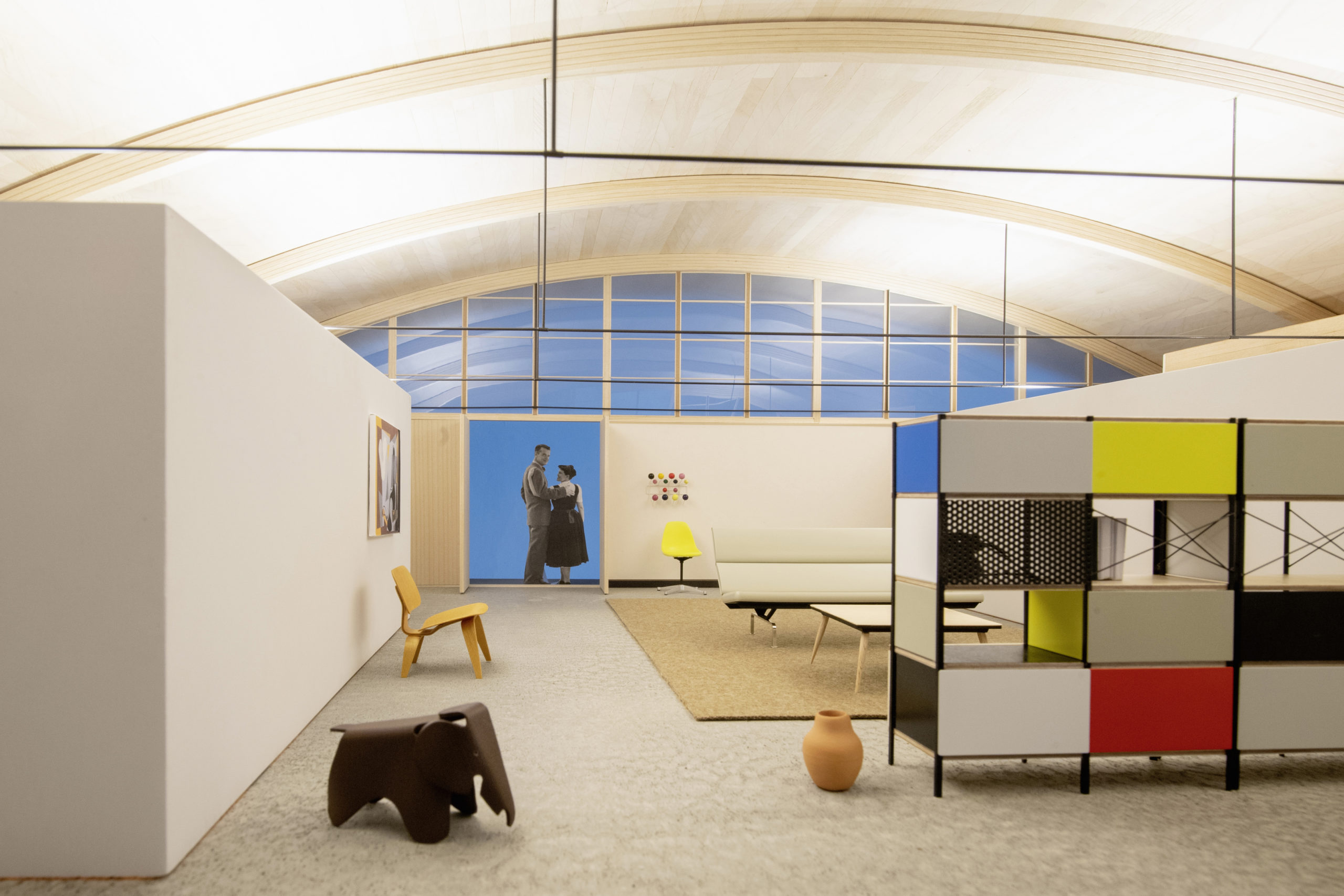Eames Office: 80 Years of Design
In celebration of the studio’s 80th anniversary, the Eames Office will present 80 Years of Design at Isetan’s gallery for modern and contemporary design ISETAN THE SPACE in Shinjuku Tokyo, Japan, from November 5, 2021 through January 5, 2022. The selling exhibition will demonstrate how the optimistic philosophies and human-centered design solutions that Charles and Ray introduced are more relevant than ever through unique, rare, and vintage works, the revival of pivotal designs from the archive, and new special editions and collaborations developed with longstanding partners Herman Miller, Vitra, and Ravensburger, and new partners Globe, Reebok, and Art of Play.

The multi-faceted exhibition will explore the seminal impact of the work of the Eames Office on society across three parts: influential experimentations in Art & Technology, groundbreaking innovations in Architecture & Interiors, and the joy and wonder brought to people of all ages through designs that encourage one to Play & Learn. A 6 meter (19.5 feet) long timeline at the exhibition’s entrance will weave together eighty years of art, architecture, furniture, textiles, film, toys, books, exhibitions, and collaborations by the Eames Office across three phases: Charles and Ray’s life and work together (1941-1978), Ray’s work following Charles’ death (1978 – 1988), and the studio’s ongoing work through to today (1988 – 2021).
“The Eames Office actively seeks to both preserve historical work and create innovative designs and experiences that extend the Eames legacy into the future. We’re thrilled to be able to present iconic works alongside special projects and collaborations that continue to bring Charles and Ray’s powerful ideas to life today.”
Eames Demetrios, Director of the Eames Office.
From their first trip to Japan in the 1950s, and the many trips that followed, to an ongoing exchange of ideas with some of the 20th century’s most well-known Japanese designers both in Japan and in Los Angeles, Charles and Ray drew inspiration throughout their career from the country’s approach to both tradition and modernity. Voracious adventurers, Japan’s impact on their worldview and work was paramount, and solidified through a formative partnership with Isetan that dates to 1961.
“We are honored to have the opportunity to celebrate the special relationship that Isetan and the Eames Office have maintained for over half a century. 80 Years of Design brings to life a prolific, multifaceted legacy and encapsulates the dynamism with which the Eames Office is forging ahead into the future.”
Kentaro Shishido, General Manager of Isetan Shinjuku.
Art & Technology
The formative years after marrying, moving to Los Angeles, and beginning the work of the Eames Office in 1941 would serve as an intense creative incubator for Charles and Ray. Charles’ rich experiences in architecture, photography, art, filmmaking, and his time in Mexico had led to two years teaching design at Cranbrook. Ray’s own artistic practice drew from her years in New York, classes with Martha Graham and, above all, her extended studies and work with painter Hans Hoffmann. This remarkable combination of the two would serve as a fertile foundation for their new creative life together. As their friend, designer Ben Baldwin said, “They had talents in different directions, and yet somehow the same direction.”

Few of their earliest breakthrough artistic experiments in the molding of plywood would be as important as their iconic 1943 Molded Plywood Sculpture, which embodies the pioneering spirit of Charles and Ray’s personal relationship, multidisciplinary working partnership, and wholly original thinking. Characterized by delicate changes in thickness and graceful 3-dimensional curves–a process they developed–the groundbreaking, innovative techniques worked out through the sculpture would give rise to some of the most important furniture designs of the 20th century. It would also directly inform the development of new types of molded wood leg and arm splints and airplane parts.
The sculpture, a centerpiece of the exhibition, has been faithfully crafted by the Eames Office in a limited edition of twelve after a rigorous year-long research and production process involving the unearthing of archival sketches and paper maquettes, and a 3D scan of the original sculpture from their personal collection to craft an aluminum mold to realize the visionary work anew.
“Charles and Ray’s sculpture represents a pivotal moment in their work, in their lives, and in design history and continues to inspire all that encounter its beauty today. For Charles and Ray, art was the best way to test the technology and the technology was the best way to make the art.”
Eames Demetrios
Ray’s gifts can also be seen in her early artworks, four of which will be on view and available for the first time as limited edition prints. Twenty vintage original molded plywood leg splints, of the more than 150,000 that Evans Products made under the direction of the Eames Office, will also be on view and available for sale.
Architecture & Interiors
In 1946, the Eames Office and Herman Miller relationship began when the company, under the influential design direction of George Nelson, began distributing, then manufacturing and marketing, the Eames furniture catalog. In celebration of their historic partnership, and the 80+ Eames Office designs that Herman Miller has put into production, the brand has developed five special edition works that honor the Eames’ dedication to material exploration. The revolutionary 1946 LCW Plywood Chair, launched by Herman Miller following the Eames molded plywood exhibition at New York’s Museum of Modern Art, will be exclusively available in a special edition duotone palisander and black. The 1950 LAR Fiberglass Chair, which pioneered the use of molded fiberglass to create an organically shaped, single-shell seat, will be presented in an Alexander Girard checker split fabric. The 1954 Sofa Compact will be available in a special edition duotone fabric from Maharam. The iconic 1956 Eames Lounge Chair and Ottoman will be available in a special edition of ten, pairing natural leather with a white oak shell. The 1960 Time-Life stool, originally designed for the Time-Life building in New York and typically crafted in solid walnut, will be available in an exclusive red-stained ash.

In 1956—after founder Willi Fehlbaum was inspired by a fateful encounter with Eames products during a 1953 visit to New York—Vitra became Herman Miller’s licensee for continental Europe and would begin its partnership with the Eames Office. Today, the rights to Eames Office designs are assigned to Vitra for Europe and the Middle East. The collaboration would leave an indelible mark on Vitra, forever transforming the company’s ethos and output from shopfitting firm to furniture manufacturer. For the exhibition, a special edition of the 1941 Eames Plywood Mobile, one of the biomorphic shapes created during their early plywood experimentation, will be available in a natural birch veneer, alongside their iconic, playful 1945 Eames Elephant. Also on view will be their iconic organic modern 1948 La Chaise, designed for The Museum of Modern Art’s 1948 “International Competition for Low-Cost Furniture Design”–and finally produced by Vitra in 1991, fulfilling two of the Eameses’ visions: the realization of a landmark design and an ongoing and dynamic Eames Office that would live beyond them.

In 1949, Charles and Ray’s pivotal collaboration in architecture began with the landmark 1949 Eames House they designed and built as their home and studio. Also known as Case Study House No. 8, it was one of thirty-six houses designed for the Case Study program initiated by Arts & Architecture magazine. Illuminating the design’s unique use of open space in both the interior and exterior, a rare ten-foot wide, 1:20 scale model will be displayed that showcases the house, furnishings, and surrounding landscape in intricate detail. While they designed their house before their first visit to Japan, many elements align deeply with traditional Japanese aesthetics. It was soon filled with objects they considered examples of good design, including many they brought back from their travels.
It is worth noting that all the Eameses’ designed structures were either specifically for people they knew well or to enrich the lives of as many people as possible. It is that more universal goal the exhibition explores next. Taking the Case Study Program ideas to the next level, the Eameses decided to build on the prefabricated aspects of their own home and their first step was the careful development of a compelling model. The 1951 Eames Modular House was designed by Charles and Ray as a structure which could be simply pre-fabricated and relatively quickly assembled. Both a sponsor and site (not far from their home) were secured for Modular House #1, but the sponsor had financial challenges, and the project was left unrealized.

70 years later, with the historic model long lost, the Eames Office spent over a year sifting through construction blueprints and photos of the original model to capture the design in a new architectural model at 1:12 scale. With its curved plywood roof, open floor plan, and highly detailed interiors including unique furniture pieces crafted at scale, the new model begins a process of recontextualizing a pioneering mid-century effort towards prefabricated modern housing in a contemporary setting. The model offers the tantalizing possibility of what could be if communities of this never-built Eames prefab were to be added to today’s architectural landscape.
Play & Learn
Engaging with playful curiosity has always been central to the practice of the Eames Office, and is the impetus for the launch of the Eucalyptus Skateboard Deck, the first in a series of collaborative projects with the Australian heritage board sports brand, Globe. Stemming from the Eames Foundation’s 250 year arbor conservation plan to protect the Eames House, the boards have been crafted from a single eucalyptus tree that stood near the home’s studio but posed a threat to the structure. For the tree’s careful, planned removal, Globe partnered with Angel City Lumber, who aims to reconnect Los Angeles residents with nature by producing wood products from the trees sourced from their own neighborhoods.

Yielded from tree #236 “Molly”, this special edition skateboard deck, in a limited numbered run of 100, draws inspiration from both the Case Study House #8 and the designs dreamt up inside of it. A nostalgic surfboard-inspired shaped deck pays tribute to skateboarding’s evolution in nearby Venice and Santa Monica. The bottom of the deck features three waves of support channels inspired by Eames Molded Plywood Folding Screens, while the top of the board includes a laser engraving of both the eminently recognizable Eames dot pattern in lieu of griptape, and a sketch of the house set behind the very trees the wooden deck is made from.
Applying the Eames legacy to contemporary culture, and purposeful functionality, the presentation will feature a recently launched special collaboration with Reebok, who designed special editions of the “Club C” sneaker with the Eames Office. Made for everyday wear, the ‘Monotone Pack’ in black and white from the first drop will be available for purchase. Pure and essential, the sneaker keeps in line with Charles and Ray’s commitment to accessible design that responds to the needs of the user. The pack features heritage accents like original size tongue tags, squared-off window boxes, die- cut tooling, classic logos, and a restored internal arch bandage for enhanced fit and comfort.
The presentation will also provide a sneak peek of a soon to come second drop, the ‘Ray Eames Signature Pack’ which will feature her 1939 Composition painting and the Eameses 1947 Dot Pattern textile, both tributes to Ray’s mastery of form and color.

Inspired by the Eameses’s thoughtful dedication to toys as tools for learning, the exhibition will include world premieres of Eames-themed puzzles created with Ravensburger, an Eames Office partner since the 1960 European launch of the Eames House of Cards. New 1000-piece puzzles will include Eames Classic Designs featuring a montage of archival imagery focused on the Eames Lounge Chair and Ottoman and Eames Design Spectrum, a mood board celebrating the myriad colors of the Shell Chair and other inspired home furnishings.

The exhibition will mark the debut of the first in a series of limited edition playing cards developed in partnership with Art of Play, the world renowned playing card experts. The first edition of Eames Playing Cards will showcase the iconic Eames Office Starburst Logo, a recurring motif in the work produced by the Eameses throughout their illustrious careers. Each edition will be packaged in a letterpress-printed tuck case, printed on sustainable paper using vegetable-based dyes.
In total, the exhibition will feature over ninety works, including art, architectural models, furniture, accessories, games, books, historical material and films, and will take over ISETAN THE SPACE, the legendary gallery on the second floor of Isetan.
For more information on the products and projects in the exhibition, and prices for the works for sale, please visit Isetan.
